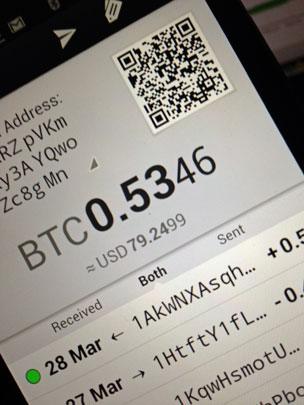The Bitcoin bubble
- Published
- comments

Yesterday afternoon I looked at my mobile phone and found that I had $121 (£79) in it. A couple of hours later though, I only had $79 (£51). But by this morning my phone told me I had $93 (£60) to spend.
Actually, what I had was 0.53 in Bitcoin, the virtual currency whose wild gyrations over the last 24 hours have raised questions about its long-term viability.
I got my Bitcoin a couple of weeks ago, because I was making a radio piece about the currency. My mission then was to work out how easy it was to get and then spend Bitcoins - and I eventually ended up with a rather expensive pizza, ordered via an American site and delivered by a London chain.
The whole cumbersome process of getting and spending the currency invented in 2009 by a mysterious Japanese (or possibly American) man called Satashi Nakamoto convinced me of one thing - that Bitcoin was not yet much use except as a means of speculation.
The only reason to get hold of Bitcoins right now is because you think they might be worth a lot more in a few hours or days. Now if you bought into the market back in January when you could get one Bitcoin for $15 (£10) you'd have been pretty smug yesterday when the price hit a new high of $260 (£170).
But if you were one of those who found out about Bitcoin from the mass of recent media and bought at yesterday's peak, then you've learned a valuable lesson - like tulips in the 17th Century and London houses in 1988, prices can go down as well as up.
There have been all sorts of explanations of what caused yesterday's crash - from a problem at the main exchange to a strange incident in which someone called Bitcoinbillionaire apparently started giving away large sums on the social news site Reddit.
A likelier reason is our old friends Greed and Fear combining to inflate and then depress prices as all those new arrivals crowded into the market.
All this talk of a Bitcoin bubble has annoyed the true believers - an interesting mixture of libertarians and cryptographic specialists charmed by the idea of a currency that embodies many of the open and virtually ungoverned principles of the internet itself.
They maintain that the key feature of Bitcoin is that the supply can never exceed a certain number - 21 million - and that it has recovered from previous crashes when its demise was predicted.
What is true is that we are seeing a fascinating experiment in what a currency of the future might look like. But unless and until Bitcoin can be used to buy a sandwich, or be accepted by your friends when you pay them back for a restaurant meal, then it is likely to remain just a playground for geeks and gamblers.